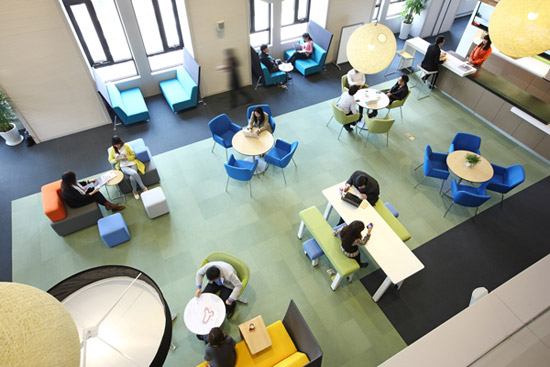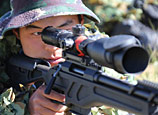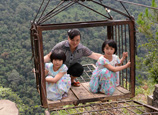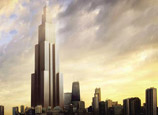
 |
| Steelcase Inc's office in Shanghai. The office furniture maker and working space solution provider's designs have lured some innovative-centered companies in China's eastern and coastal cities. PROVIDED TO CHINA DAILY |
Firm designs office furniture that make staff much more productive, VP says
At a time of an increasing turnover rate of employees, some business leaders believe more benefits may help to persuade the most productive employees to stay, while some offer more incentives such as paid holidays or stipends for training or studying for a degree. Gale Moutrey, vice-president of Steelcase Inc, a multinational office furniture provider, said she believes a pleasant and comfortable environment that encourages collaboration and innovation are most attractive to the greatest minds.
The 55-year-old has been working for the more than 100-year-old company for almost three decades — since 1984.
Steelcase has been providing working space solutions to some of the world's leading innovative enterprises including Google Inc and Facebook. This year, it unveiled its latest innovation, Gesture, a smartphone-user-friendly chair (more on which later) in Shanghai — a thriving market with an expanding demand for inspiring working environments.
In China, Steelcase sells through company-owned and independent dealers to end users — usually multinationals. Its designs have lured some innovative-centered companies in China's eastern and coastal cities, such as Shanghai and Nanjing, in Jiangsu province. "One of our young colleagues in the Shanghai office was so attracted by our working environment when she passed by our office that she came in to ask if there was any job vacancy she could apply for — and she joined us," said Moutrey.
Understanding first
Moutrey's career at Steelcase began as a salesperson and then she became sales manager. Later, she moved to marketing — from launching and managing furniture systems in North America to marketing director in Canada. While in that role she assumed responsibility for a special brand project that explored how Steelcase could enhance the brand experience it offered to clients and design professionals. That led to the position in which she currently serves.
For Moutrey, understanding is a result of outstanding communications. "Outstanding communications are those that are truly relevant to the audience they were designed for and make a difference to the life or work of that person or organization," said Moutrey.
The best working space is one that offers people choice and control over where and how they work, so they can choose the right place with the right tools for whatever they are doing at a particular moment, whether it's working alone or with others, side by side or across the globe, she added.
For the new chair, Gesture, launched in Shanghai in April, Steelcase's research and development team studied some 2,000 people around the world. They discovered nine new office chair postures born from the way people use mobile devices nowadays. With improved reclining back supports, floating arms that provide support while typing or texting and even a seat that's comfortable to sit on right at the edge, Gesture is designed to be flexible and adapt to how people really want to sit throughout the day so they remain comfortable no matter how bizarre their pose.
"We believe the best places are the ones that have been designed with the physical, social and cognitive well-being of people who use them in mind," said Moutrey.
In China, office furniture manufacturing has a history of more than 100 years. The market has increased to many billions of yuan since the 1980s.
However, Steelcase sees hardly any domestic competitor understanding how to provide working environment solutions. It is still a concept at quite an early stage in the minds of Chinese companies. Some local furniture manufacturers have copied or borrowed the looks of Steelcase's products but they are unable to provide core technologies, patents and materials created by Steelcase.
Herman Miller and Haworth Inc, Steelcase's principal competitors in the office furniture industry, are also strong rivals in the global market. Both of them have a presence in China. Herman Miller is especially famous for its designs of furniture items such as chairs, while Haworth is strong in providing adaptable workspaces, including office furniture, seating, partitions and floors.
Concerning the competition, Moutrey said Steelcase is the first and the only enterprise in the field that researches the working environment in a holistic fashion. It provides not only furniture but also solutions to the demands of the working environment — known as "strategic tools".
Steelcase's communication with clients and design professionals starts with conducting fieldwork at a company's working spaces and can be as detailed as choosing the textile of sofa covers.
The company also uses its own people and spaces to test ideas and solutions. It openly shares these experiences and results with customers and the designers it partners with.
Between 2006 and 2011, Steelcase set out to delineate the connection between space and culture in 11 nations, including China, France, Germany and the United States. The researchers observed more than 100 workplaces, measuring culture codes in six ways, involving power-distance indexes, degree of individualism/collectivism, masculine/feminine usage, uncertainty tolerance, long-term or short-term orientation and high or low context.
Researchers found that most Chinese companies are hierarchical, collectivist, success-oriented, tolerant of uncertainty, long-term oriented with communication given a high degree of importance. All of these findings influence design in China.
Changing market
Hierarchies continue to be embraced by workers to maintain harmony and order. Executive and manager offices are important symbols of respect and order. Because of the cultural norms of reticence and task orientation, collaboration is a significant behavior change for Chinese workers.
Yet attitudes about space are shifting as outside influences expose Chinese organizations to new ways of working. Spaces that promote collaboration and innovation should be blended with traditional views of hierarchy, according to a report by Steelcase.
"The studies are inspiring. We don't assume that one workplace can be transplanted from one country to another. It is essential to find the right balance between local and global," said Moutrey.
Steelcase strives to optimize working space designs to reduce rent cost, strengthen collaboration, attract and cultivate talented people, manifest brand and cultures and enhance the well-being of employees.
Steelcase sees China as a fast-growing market with huge potential demand. Office building space has increased drastically amid the nation's expanding business activities and intensive infrastructure construction.
According to data from the National Bureau of Statistics, office building space in the east regions of China, including Beijing, Shanghai, Tianjin and nine coastal provinces, increased 25 percent year-on-year in the first half of 2013.
In Shanghai alone, construction of some 1.2 million square meters of office building space started in June.
Steelcase also looks at changes that may occur in future workspaces, especially those for younger workers born after the 1980s.
As residents of one of the world's hottest centers of economic growth, young people in China are breaking new ground while surrounded by traditional ways of life and work.
They have been embracing new trends in life. Shifts in their perception toward life and work have been observed in several aspects, said Moutrey.
Harmony was and is the basis of social behavior in China, but it is not all about conformity. Rather, individuals have learned to adjust their identities to blend with the society around them, as members of a group, rather than as individuals. Now, young people are starting to create their own identities based purely on their own interests.
This can sometimes create conflict with traditional values, although the post-80s generation still retains strong values of responsibility to family.
"As hierarchy eases its hold, teams are encouraged to contribute more. Collaboration will become easier as people become more comfortable expressing differing opinions and working constructively through conflict, but today it can still be a struggle," said Moutrey.
As an example, a design known as the Fireplace was designed by Steelcase for young Chinese workers. It includes a soft sofa, coffee bar and tables that people can write on and has become one of the most popular corners in the office.
"Young people would love to share their opinions with others in an environment that encourages openness. Communication cannot be smooth if the environment is suffocating, for example if you are caged in a narrow room," said Jean Zhang, a 23-year-old accountant at a foreign trading company in Nanjing.
"Employers in China used to think only about employees when they were at work doing their jobs. Now, young employees expect to get more out of the work experience — and progressive employers are responding," said Moutrey.
Today, young Chinese employees attach great importance to their work and life balance. They are becoming explorers, not just labor. Instead of applying for whatever job may be available, they are applying to companies that seem to offer the most opportunities for growth. Young Chinese people want to develop a career path of their own and are not afraid to change jobs to do that.
"It's all about how you love your work," said Moutrey.
















 Dog survives after 30 hours buried in debris
Dog survives after 30 hours buried in debris


![]()
